Locations, Locations, Locations
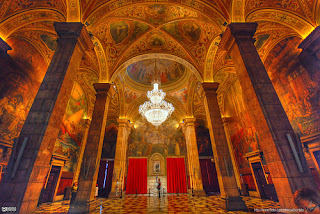
INT./EXT. WHERE SHOULD THIS DAMN SCENE TAKE PLACE
Ironically, little has been written in screenwriting books (and around scribosphere) about how to pick locations for your screenplay. This is important stuff! And it is such a pet peeve of mine when writers are so thoughtless, unoriginal, and uncreative about locations in their scripts. (Or they keep returning to the same boring location again and again. Or a protagonist goes halfway around the world to Italy only to spend the majority of the time in a hotel room. Are you kidding me? If you’re going to Italy, then show me Italy! I don’t need the country to be showcased like some vacation video, but please, let me soak up the sights and sounds and culture within the story.)
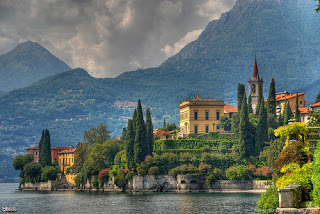
I have a number of thoughts about locations.
First, know your story. The locations cannot dictate the story; the story must dictate the locations. So do the homework. Do the character development sheets. Do the outline. Have a god-like knowledge about the world of your story. Know your themes, your conflicts, and your resolutions. Then you’ll make wise decisions about locations.
Second, once you know your story, you should make decisions about the visual palette of your screenplay. I think there’s an enormous significance to a script’s visual palette and the movie images you’re putting into the mind’s eye of your reader. It disappoints when you lack originality. It disappoints when your visuals are clichéd or unoriginal or lifted from another source. (Just because you like something from another movie doesn’t mean you should incorporate it into your script. It may not necessarily be the right fit. You have to consider your story on its own terms and what’s best for YOUR story. Besides, I think you’re better off considering all of the other films that have been made about similar subjects or themes and use that to make decisions about how your script will be distinctively different not only in terms of the story but also the visuals.) You may recall my post about Away From Her where I wrote, “We also have to recognize that a screenplay is the foundation to a film’s visual palette and that lightness and darkness and tone are monumental considerations to make when comparing your screenplay to other films on a similar subject. Ebert wrote about how we see this story ‘not in darkness and shadows and the gloom of winter and visions in the night, but in bright focus. Polley told Andrew O’Hehir of Salon: ‘For me the overriding palette that we were working with was the idea of this very strong, sometimes blinding winter sunlight that should infuse every frame. I didn’t want the visual style to draw too much focus to itself. I felt like this needed to be an elegant and simple film, and that it had to have a certain grace.’”

Having said that, there are practical considerations to be made about a certain location. Is it do-able? Can you get permission to film there? Don’t even think about it. If you can’t film there, it could be reproduced in a studio, but that costs money and you have no idea what the budget will be if your script gets produced, so don’t worry about it. I think some writers choose cheap locations so as to impress people by how well they can save money, when ultimately, a writer should write to inspire people with a great story, not prove how cost-conscious he/she can be. Always aim for the best locations that serve your story but be willing to make changes as the needs of a production evolve.
There are only two kinds of locations you can choose:
NATURAL or UNNATURAL
(I first had “man-made” instead of “unnatural,” but then I could imagine someone saying, “Well, what about alien spaceships? Is that ‘man-made’ too?” Okay, fine – “unnatural.”)
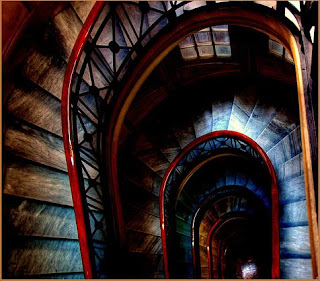
UNNATURAL
There are a number of things to be said about man-made locations. Consider the setting of the story. How does this affect or make statements about the characters? You may recall in an earlier post on Cinematic Storytelling, we talked about Strangers on a Train and there was a moment early in the film in which Hitchcock cut to an exterior moving shot of the train tracks, as if the camera was bolted to the front of the train. We smoothly glide along one set of tracks, and then we come upon one and two and then multiple intersecting tracks. Suddenly the train veers off suggesting that the protagonist has done the same.
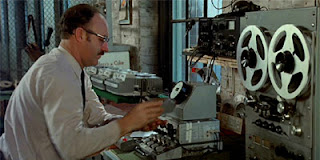
In my second Art of Visual Storytelling article, I talked about The Conversation. Harry Caul’s personal environment came out of Francis Ford Coppola’s interest in repetition through symbols of the circular. To quote Jennifer Van Sijll from her book, Cinematic Storytelling, “What is being repeated is man’s emotional weakness represented by deceit and betrayal… Harry is a surveillance expert. His outer person is symbolized by the linear. He is rational, technically competent, detached, and remote. Coppola gives him clothes and a physical environment made up of straight, elongated lines. Harry’s job is dependent on the circular spinning wheels of the tape recorder. As long as he stays detached from their content, he is competent and stable.” Harry, of course, gets drawn into the emotional lives of his subjects, which is his undoing, as the surveillance expert becomes the surveillance subject. There's a scene toward the end where he tries to change the outcome and enters the building of the man who hired him. The building is linear on the outside but circular on the inside – just like Harry. As Jennifer wrote, “Once inside, he is confronted on the circular stairwell by corporate thugs. Below him is a floor tiled in a circular pattern. Once ejected from the building, he is safe again. He walks along the linear structure almost disappearing into its gray lined walls.”
Consider Hedwig and the Angry Inch, about a young man who struggles with his sexuality set in the backdrop of Berlin, a city divided by a wall. A man-made wall, by the way, divided two lovers in Bob Thielke’s completely visual screenplay. I once wrote a script (just for fun) that incorporated the French Riviera as a setting to represent a particular character because the deeper you explore the city, the colors get darker and the streets are more twisted. I just think that we're the ones who are expected to explore the world, ya know, and internalize what we learn about cities and structures and shapes and cultures in order to incorporate those nuggets into films to show the world and movies in a new light that we haven’t seen before.
On that note, here are four inspirational visuals:
Nature overtaking man:
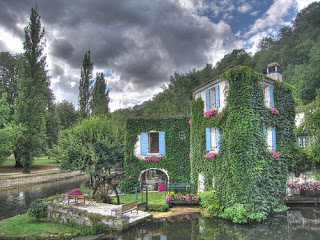
Nature bringing light into a character’s darkened world:
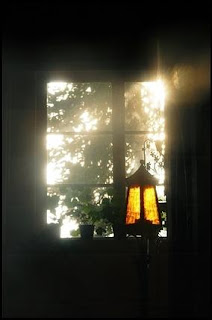
Contrast of old vs. new:

And reflection vs. reality:
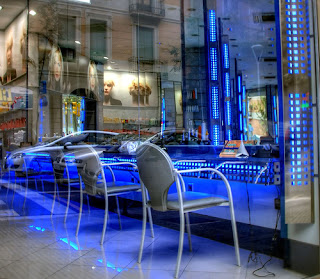
Even on a more practical level, ask yourself, “What kind of statement does this location make about the character?” (That question makes me think of Billy Wilder’s The Apartment and Holly Golightly’s pad in Breakfast at Tiffany’s.) Other questions: “Can the character afford to live here?” “What feeling does this location evoke?” “Would it make the audience nervous, uncomfortable, or would it give them warm & fuzzies all over?” “Does it add a sense of wonder to the story?” “How does this location add or undermine the tension?” “What’s better for an argument – a loud marketplace or a library? While someone’s at work or after they get home? On the phone or in person?” “Have we seen locations like this a million times before?” “Where can we go that we’ve haven’t seen?” “How can I show this tired location in a new light?”
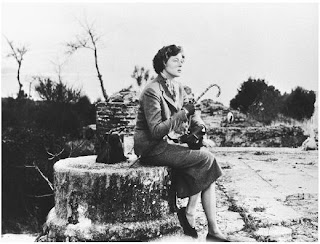
Since reading Girish’s recommendation, I’ve been going through the book, 1000 Defining Moments in Movies, and I found an entry worthy of our consideration. Contributing writer Miguel Marias offers up a key scene from Roberto Rossellini’s 1953 film Voyage in Italy starring Ingrid Bergman and George Sanders. To quote Miguel:
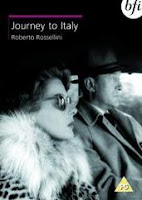 “An English couple journeying in Italy to clear up the affairs related to a recently deceased uncle’s estate have, while forced to stay together in a strange environment, wandered apart, realizing what they had so far avoided to admit through each living his or her own lives. They have just said the words ‘let’s get a divorce,’ when they have to accept an invitation to see new archeological discoveries in the ruins of Pompeii, an ancient city buried in lava and ashes after a cataclysmic volcanic eruption. The people working on the ongoing excavation slowly and carefully unearth what seems at first an arm, then two legs, then a skull from which, delicately, the earth is brushed off to reveal the plaster cast of a disintegrated head. Finally, there appear – much like photographed images appearing on a film as it is developed – the full bodies of a man and a woman who died suddenly in their sleep as they lay together in bed and who now look like the sculpture of a couple. We make these discoveries gradually and at precisely the same time as do the two characters, Katherine (Ingrid Bergman) and Alex Joyce (George Sanders), so that we can fully share or at least understand their reaction; both are impressed, and Katherine is affected so deeply that she wants to leave the place. As Alex escorts her out of the ruins towards their car, he admits, “I was pretty moved myself” – a first step towards mutual understanding, which prepares us to accept as (barely) feasible the almost miraculous reconciliation of the couple.”
“An English couple journeying in Italy to clear up the affairs related to a recently deceased uncle’s estate have, while forced to stay together in a strange environment, wandered apart, realizing what they had so far avoided to admit through each living his or her own lives. They have just said the words ‘let’s get a divorce,’ when they have to accept an invitation to see new archeological discoveries in the ruins of Pompeii, an ancient city buried in lava and ashes after a cataclysmic volcanic eruption. The people working on the ongoing excavation slowly and carefully unearth what seems at first an arm, then two legs, then a skull from which, delicately, the earth is brushed off to reveal the plaster cast of a disintegrated head. Finally, there appear – much like photographed images appearing on a film as it is developed – the full bodies of a man and a woman who died suddenly in their sleep as they lay together in bed and who now look like the sculpture of a couple. We make these discoveries gradually and at precisely the same time as do the two characters, Katherine (Ingrid Bergman) and Alex Joyce (George Sanders), so that we can fully share or at least understand their reaction; both are impressed, and Katherine is affected so deeply that she wants to leave the place. As Alex escorts her out of the ruins towards their car, he admits, “I was pretty moved myself” – a first step towards mutual understanding, which prepares us to accept as (barely) feasible the almost miraculous reconciliation of the couple.”
NATURAL
I could write volumes about nature in films. I think to find the right placement in your story as a setting for a scene is to ask first what that scene’s about. Nature can be a sanctuary or it can be a force of death. Nature can represent anything and it can be used as a metaphor for everything. You just have to consider the relationships between forces and objects in nature and consider how it relates to your story. At Symbolism.org, they have an article on the Symbolism of Place and talked about the four basic elements of water, fire, earth, and air:
“Perhaps the most obvious general symbolism of the elements is the division between masculine and feminine. Fire and air represent the Yang within Chinese thought and symbolize the masculine archetype, the active state and the thinking function. Water and earth represent the Yin within Chinese philosophy and symbolize the feminine archetype, the passive state and the intuitive function. Fire and air have found a historical association with the sky and a relationship with the well-known symbolism of the Sky Father. The earth and water have been associated with the symbolism of Mother Earth. As Jung notes in his article "Psychology of the Transference" in The Practice of Psychotherapy, "Of the elements, two are active - fire and air, and two are passive - earth and water."
“For example, fire is associated with the sun and the light of day which relates to consciousness. It is an above space phenomena in that the quality of fire moves upward rather than downward. Our sensory perceptions relates fire to both the heat of the day and the heat of the summer season when light rules over darkness. Water is the element whose symbolism stands in direct opposition to that of fire. It is associated with unconsciousness, the darkness of night and the moon's monthly cycles which control ocean tides. While fire moves upward water moves downward and is associated with below space rather than above space. The element of air has a masculine archetype and the element of earth a feminine archetype. Again, there is a similar symbolism with these two elements and those of fire and water. Air is an above space because it is most present above the earth rather than in the earth or below the earth. Like water, the earth is a below space rather than an above space.”

I’m going to close this with another key scene taken from 1000 Defining Moments in Movies. This can show how the same location can be used for both joy and sadness. It’s taken from a 1964 Denmark film by Carl Dreyer called Gertrud and starred Nina Pens Rode and Baard Owe. Here’s what Jonathan Rosenbaum’s wrote:
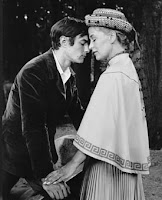 “‘She awoke at last to find herself getting laid; she’d come in on a sexual crescendo in progress, like a cut to a scene where the camera’s already moving.’ Curiously, this sentence by Thomas Pynchon in The Crying of Lot 49 (1966) comes only two years after the release of Carl Dreyer’s final feature. This isn’t to suggest any influence – only a striking congruence with a cut to a scene where the camera’s already moving as it follows Gertrud’s (Rode’s) determined stride across a park to keep her rendezvous with Erland Jansson (Owe), the much younger composer she’s fallen in love with. In the previous scene – ponderously paced, in a claustrophobic flat – she has just told her stuffy middle-aged husband at some length that she no longer loves him and is leaving him. And Dreyer’s sudden cut in media res to her moving towards Erland expresses infatuation and orgasmic passion like few other camera movements in cinema – as if to replicate both her impatience and her ecstatic anticipation… They meet at a bench beside a placid pond that seems to glisten with Gertrud’s happy rapture. Much later in the film, when Erland breaks her heart in the same setting, the same pond is ruffled by quiet turbulence, but here it shines with joy.”
“‘She awoke at last to find herself getting laid; she’d come in on a sexual crescendo in progress, like a cut to a scene where the camera’s already moving.’ Curiously, this sentence by Thomas Pynchon in The Crying of Lot 49 (1966) comes only two years after the release of Carl Dreyer’s final feature. This isn’t to suggest any influence – only a striking congruence with a cut to a scene where the camera’s already moving as it follows Gertrud’s (Rode’s) determined stride across a park to keep her rendezvous with Erland Jansson (Owe), the much younger composer she’s fallen in love with. In the previous scene – ponderously paced, in a claustrophobic flat – she has just told her stuffy middle-aged husband at some length that she no longer loves him and is leaving him. And Dreyer’s sudden cut in media res to her moving towards Erland expresses infatuation and orgasmic passion like few other camera movements in cinema – as if to replicate both her impatience and her ecstatic anticipation… They meet at a bench beside a placid pond that seems to glisten with Gertrud’s happy rapture. Much later in the film, when Erland breaks her heart in the same setting, the same pond is ruffled by quiet turbulence, but here it shines with joy.”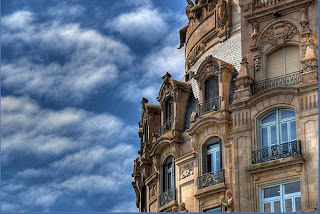
A few links:
Photos by Mor and Szefi
Art of Visual Storytelling
1000 Defining Moments in Movies





















8 comments:
Great article MM! Will be recommending this to my script reading clients. Thanks!
Great article indeed.
This is a bit off-topic and perhaps you've blogged about it before, but... MM, what would be your list of must-see films for screenwriters?
McKee's is obviously Chinatown and Casablanca. What's yours?
Thanks, Lianne.
Hey, Elver! I have two things to say about that. A) I don't believe in models for screenwriters, especially this notion McKee had about Casablanca. Every genre has its own collection of unique masterpieces, so you have to study the genre that you're working in. B) In terms of films to watch, I'm personally trying to get through Jonathan Rosenbaum's Top 1000 Films. That's a good start.
-MM
Film is a visual medium. I use that line in nearly every review I do, because beginning screenwriters seem to forget that we SEE the story unfolding on the screen.
Every story has a visual palette. If you can find the particular palette for your story, the rest of it will fall into place.
such a minor glitch in such a good article -- Hedwig and the Angry INCH, thank you.
Thanks, Mim.
Con - I was ROLLING when I read that. I can't believe I did that. Well, it's been fixed. Thanks so much for that.
-MM
Sohbete inananların bulustugu yere gitmek için burayıSohbet odalarıTurkiyede Chat'in gercek adresine gitmek için burayıChatistanbullularla sohbet etmek için ise burayıistanbul sohbetEger aşkla ilgili bişilere bakacaksanız burayı tıklamanız yeterli olacaktır.Mynet Sohbet thanks you very much.
Sohbet Siteleri | Chat Siteleri | Sohbet | Mynet Sohbet | Sohbet Odaları | iStanbul Sohbet | iStanbul Chat | Chat | Mynet Sohbet | Sohbet Odaları | Mynet Sohbet
Post a Comment